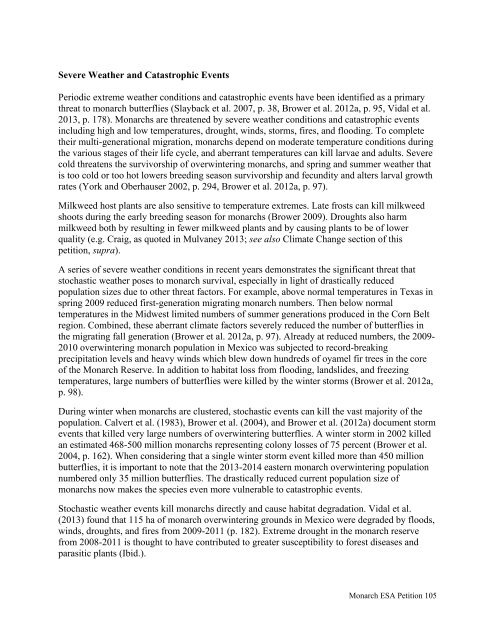monarch-esa-petition-final_61585
monarch-esa-petition-final_61585
monarch-esa-petition-final_61585
Create successful ePaper yourself
Turn your PDF publications into a flip-book with our unique Google optimized e-Paper software.
Severe Weather and Catastrophic Events<br />
Periodic extreme weather conditions and catastrophic events have been identified as a primary<br />
threat to <strong>monarch</strong> butterflies (Slayback et al. 2007, p. 38, Brower et al. 2012a, p. 95, Vidal et al.<br />
2013, p. 178). Monarchs are threatened by severe weather conditions and catastrophic events<br />
including high and low temperatures, drought, winds, storms, fires, and flooding. To complete<br />
their multi-generational migration, <strong>monarch</strong>s depend on moderate temperature conditions during<br />
the various stages of their life cycle, and aberrant temperatures can kill larvae and adults. Severe<br />
cold threatens the survivorship of overwintering <strong>monarch</strong>s, and spring and summer weather that<br />
is too cold or too hot lowers breeding season survivorship and fecundity and alters larval growth<br />
rates (York and Oberhauser 2002, p. 294, Brower et al. 2012a, p. 97).<br />
Milkweed host plants are also sensitive to temperature extremes. Late frosts can kill milkweed<br />
shoots during the early breeding season for <strong>monarch</strong>s (Brower 2009). Droughts also harm<br />
milkweed both by resulting in fewer milkweed plants and by causing plants to be of lower<br />
quality (e.g. Craig, as quoted in Mulvaney 2013; see also Climate Change section of this<br />
<strong>petition</strong>, supra).<br />
A series of severe weather conditions in recent years demonstrates the significant threat that<br />
stochastic weather poses to <strong>monarch</strong> survival, especially in light of drastically reduced<br />
population sizes due to other threat factors. For example, above normal temperatures in Texas in<br />
spring 2009 reduced first-generation migrating <strong>monarch</strong> numbers. Then below normal<br />
temperatures in the Midwest limited numbers of summer generations produced in the Corn Belt<br />
region. Combined, these aberrant climate factors severely reduced the number of butterflies in<br />
the migrating fall generation (Brower et al. 2012a, p. 97). Already at reduced numbers, the 2009-<br />
2010 overwintering <strong>monarch</strong> population in Mexico was subjected to record-breaking<br />
precipitation levels and heavy winds which blew down hundreds of oyamel fir trees in the core<br />
of the Monarch Reserve. In addition to habitat loss from flooding, landslides, and freezing<br />
temperatures, large numbers of butterflies were killed by the winter storms (Brower et al. 2012a,<br />
p. 98).<br />
During winter when <strong>monarch</strong>s are clustered, stochastic events can kill the vast majority of the<br />
population. Calvert et al. (1983), Brower et al. (2004), and Brower et al. (2012a) document storm<br />
events that killed very large numbers of overwintering butterflies. A winter storm in 2002 killed<br />
an estimated 468-500 million <strong>monarch</strong>s representing colony losses of 75 percent (Brower et al.<br />
2004, p. 162). When considering that a single winter storm event killed more than 450 million<br />
butterflies, it is important to note that the 2013-2014 eastern <strong>monarch</strong> overwintering population<br />
numbered only 35 million butterflies. The drastically reduced current population size of<br />
<strong>monarch</strong>s now makes the species even more vulnerable to catastrophic events.<br />
Stochastic weather events kill <strong>monarch</strong>s directly and cause habitat degradation. Vidal et al.<br />
(2013) found that 115 ha of <strong>monarch</strong> overwintering grounds in Mexico were degraded by floods,<br />
winds, droughts, and fires from 2009-2011 (p. 182). Extreme drought in the <strong>monarch</strong> reserve<br />
from 2008-2011 is thought to have contributed to greater susceptibility to forest diseases and<br />
parasitic plants (Ibid.).<br />
Monarch ESA Petition 105




